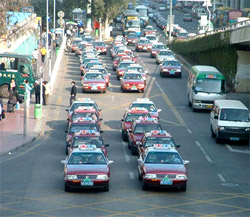Hong Kong Transportation
 Airport Info
Airport Info
Hong Kong is the main gateway to China and much of East Asia. Therefore, the international air service is excellent and competition keeps the fares relatively low compared to neighboring countries.
Hong Kong International Airport, also known as Chek Lap Kok, is a highly modern institution set on reclaimed land off Lantau Island.
Getting Around
Hong Kong is small and crowded, therefore public transport is the only practical way to get around. Consequently, public transport is cheap, fast, widely used and generally efficient.
Key to Transportation Abbreviations:
MTR Mass Transit Railway (subway)
KCR Kowloon-Canton Railway
LRT Light Rail Transit
HKF Hong Kong Ferry
Bus
The extensive bus system offers a bewildering number of routes that take you just about anywhere in Hong Kong. Most visitors use the buses to explore the south side of Hong Kong Island and the New Territories. Northern Hong Kong and Kowloon are best explored and well-served by the MTR.
In Central, the most important bus station is on the ground floor under the Exchange Square. From this station, you can catch buses to Aberdeen, Repulse Bay, Stanley and other southern destinations.
In Kowloon, the Star Ferry Bus Station is the most useful, with buses to the KCR station and points in eastern and western Kowloon.
?Ferry
Hong Kong¡¯s ferries are almost always faster and cheaper than the buses and provide fantastic photo opportunities. The Star Ferry crosses the harbour between Central and Kowloon, taking just 7 minutes. Ferries operate every 5-10 minutes. Adults over 65 years of age ride free and there are discounts for children under 12.
The HKF Company operates a number of useful ferries and hovercraft between Hong Kong, Kowloon and the New Territories. Hovercraft are twice as fast as conventional boats, more modern and more comfortable. The drawback is that they are not particularly smooth and when the weather is rough, hovercraft bounce considerably.
HKF also operates ferries to the Outlaying Islands of Lantau, Lamma, Cheung Chau and Peng Chau islands. These ferries depart from in front of Exchange Square in Central. The piers are all clearly signposted. On weekends, there are a few ferries to Lantau and Cheng Chau from the Star Ferry terminal in Tsim Sha Tsui in Kowloon. Fares are reasonable, except on weekends when the prices nearly double.
?Light Rail Transit (LTR)
The LTR is like a modern, air conditioned version of the rickety old tram. ?However, the LTR is much faster and runs along the city streets and stops at designated stations. Some routes connect with the MTR routes.
?Mass Transit Railway (MTR)
The MTR is clean, fast, safe and easy. It is one of the world¡¯s most modern subway systems. Though it costs a bit more than other forms of public transport, it is the quickest way to get to most destinations. Trains run every 2-4 minutes from 6am to 1am daily on three lines. Fares range from HK$5 to HK$15. If you plan on doing a lot of traveling, the Octopus Card offers excellent value on MTR, LRT, KMB, City bus and HKF ferries. Octopus Cards can be purchased from ticket offices or customer service centers in MRT, KCR East Rail and LRT stations, and certain ferry piers of the HKF.
For short trips, the MTR is not the best value. For example, if you want to cross the harbour from Tsim Sha Tsui to Central, the MTR is about five times the price of the Star Ferry without the views and is only slightly faster. However, if your destination is further away, the MTR is considerably faster than a ferry or bus and about the same price.
Taxi
Hong Kong taxis are not too expensive compared to other major modern cities. With more than 18,000 cruising the streets, taxis are usually easy to flag down, except at bus stops and restricted areas where the curb is painted yellow. Taxis can also be difficult to flag during rush hours. Taxi fares start at around HK$15. If you go through any harbour tunnels, you must pay twice the toll as the driver¡¯s return toll has to be paid as well.
Many taxis have a card that lists the top 50 destinations in English, Cantonese and Japanese. This is useful as most drivers don¡¯t speak English. It¡¯s a good idea to have your destination written down in Chinese. If you leave something behind in the taxi or feel a taxi driver has ripped you off, get the taxi number and call the police hotline on 2527-7177.
Travelator
The Travelator is the world¡¯s longest escalator and consists of elevated escalators and moving sidewalks. It caters to the commuters who live up on the steep hillside and work down in the city, but it can be a fun way to sightsee as well.
Tram
Trams are tall and narrow double-decker streetcars that service northern Hong Kong Island. The trams are not fast, but they are cheap and a fun way to sightsee. For a flat fare of HK$3 you can go as far as you like. The longest route is from Kennedy Town to Shau Kei Wan, taking around 90 minutes. Trams operate between 6am and 1am at 2-7-minute intervals.
Note:? For more information on all public transport in Hong Kong, please visit this web site: www.td.gov.hk/
Vehicle Hire
There is no need to drive yourself around Hong Kong, unless you are planning an excursion to the New Territories. Even then, you may do better with public transport unless you are going to a very remote location. Car rental companies require either an International Driver's Permit or one from your home country and a credit card deposit of HK$5000. Drivers must be at least 25 years of age. Daily rates range from HK$700 for a small car to HK$3000 for an up-market vehicle. Reputable car rental companies are: Ace in Happy Valley (Tel: 2560-8689); and Avis in Causeway Bay (Tel: 2890-6988)